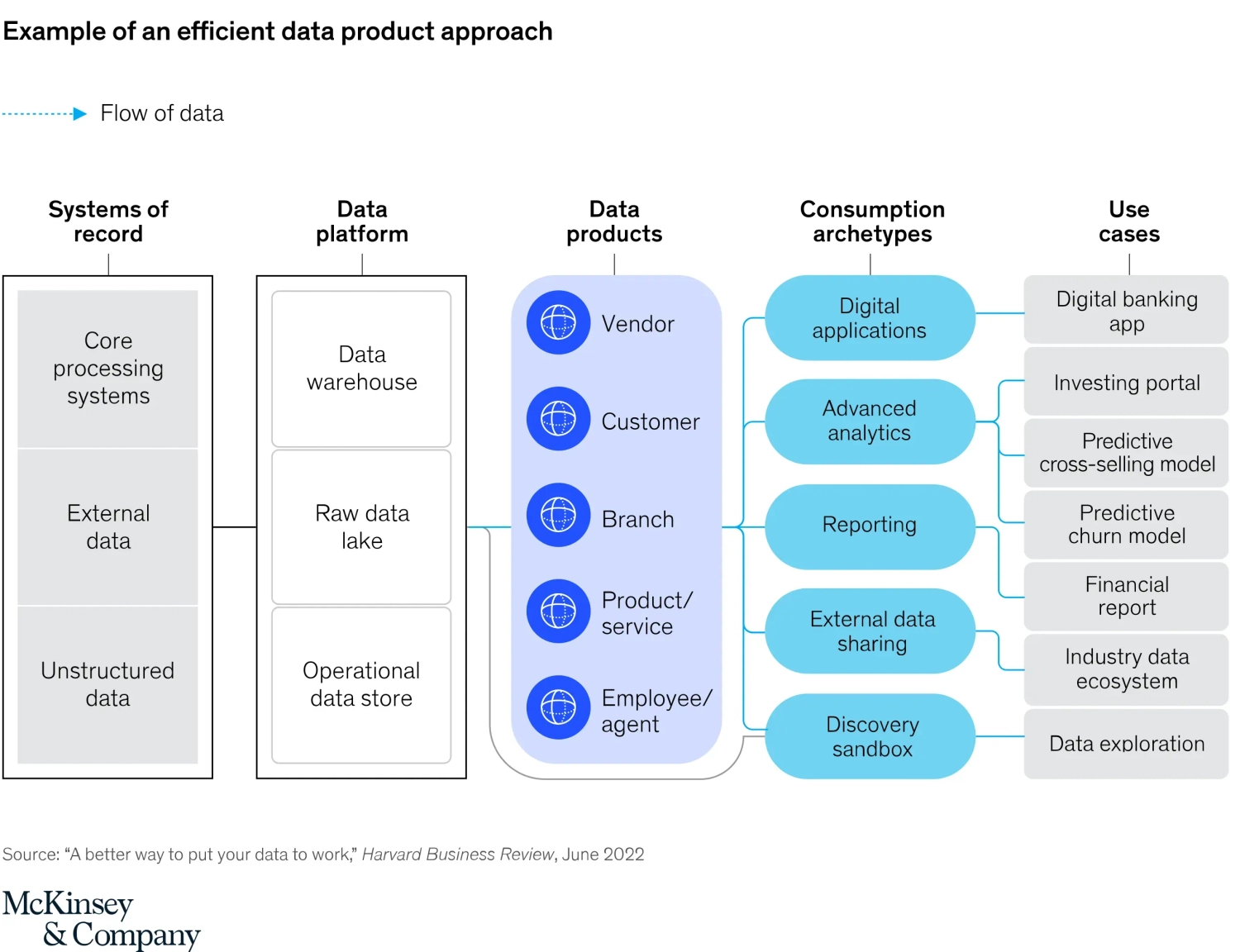From this article you will learn:
- What are ineffective data management strategies.
- How to create analytics products.
- Where to start the changes.
Companies are now investing massively in the development of information technologies that enable the collection, gathering and use of data. According to a recent Big Data and AI executive survey 2021 report by NewVantage Partners, only 41% of those companies investing in new IT technologies are able to actively use data to build competitive advantage. This means that a full 59% of the investment potential is wasted or underutilized. These results are not at all shocking to consulting firms that have been helping clients with digital transformation for years. Experts repeat like a mantra that "data is the new fuel that drives the economy," and any leader looking to the future no longer has a choice between "being or not being" a data-driven organization.
However, a data-driven organization is not just the implementation of the latest technology and eons of data floating in the cloud available at your fingertips, where each user, like a fisherman, will cast a fishing rod and catch his life's catch. In order to succeed in building and sustaining an organization that can build its growth based on data, you mainly need to create the right environment for novices as well as avid fishermen.
There are currently two dominant approaches to data management, and both are ineffective and fail to meet the needs of decision makers who face challenges accessing valuable analytics instead of deriving insights from data. I use the word ANALYSIS very deliberately here. The data itself may be a valuable resource for the organization, but without correct, in-depth analysis of the data, it does not add value to the business.
Bottom-up approach
The bottom-up approach is the first of the two approaches I mentioned above. Its special characteristic is the creation of data sources in separate units of the organization without a common strategy for their management. The result of such arbitrariness is burned hours and money in building ineffective solutions, often fraught with design errors and technology debt. Moreover, such silo-built solutions are difficult to maintain due to a lack of infrastructure and appropriate competencies. Unfortunately, as I often observe in my work, the data provided is of poor quality, and the analysis performed on it can lead to erroneous conclusions, which has a direct negative impact on decision-making. Worse, this approach creates space for subjective use of data. Each entity, relying, to the best of their knowledge, on the same data, presents different aggregations of it and consequently presents different results. In general, high-level accounting, this can lead to a lack of trust between business partners as well as in the validity of the data used.
Centralized approach
The second most common trend is the creation of a separate, centralized unit within the organization to ensure the quality and availability of data for other business units. This approach, compared to the previous one, certainly curbs all discussions regarding trust in the data source, as it creates a so-called single source of truth. However, it is not a perfect solution either. To do its job well in an organization, it should be an extensive, well-funded cell that supports the other units quickly and with an understanding of the specific needs of the business. Unfortunately, for the most part, such cells are heavily technical with a focus on providing data rather than delivering value through data.
What is the right approach?
I always think it is worthwhile to peek and learn from the best. The approach I've been using successfully for a couple of years is one taken directly from product design.
The two typical approaches described above diverge. In the bottom-up approach, data quality is lacking, but instead we can expect to understand business needs, as those responsible for providing data are closer to the business. In centralization, perhaps the quality and efficiency of the data management processes is high, but we can expect problems related to the use of data in the right space-time due to the rather bureaucratic nature of the approach. And here the product approach can be a real game changer, elevating analytics in the organization to a completely different level.
I am not alone in my opinion. Similar findings can be found in a recent publication by consulting industry leader McKinsley, which points out that with a product approach you can save up to 30% of the overall cost of data management including technology, development and maintenance[1]. The heart of the product approach is to look at data from the point of view of the value it generates for decision-makers. And as you know, different individuals in an organization have different decisions to make, through which they contribute to growth. Let's consider, does the CFO focus his attention on the same information as the marketing director? Are they equally interested in customer loyalty and lead conversion? But will the CFO be more interested in the company's assets and liabilities, which can give the marketing director a headache?
The product approach focuses on creating interdisciplinary teams combining business people with technical people and working closely with the business to confront progress with business needs on an ongoing basis. The use of this approach can be applied broadly from ensuring the right data sets are in place, to reporting to data availability in sandboxes for advanced analysis (Figure 1).

How do you start the changes?
The product approach is based primarily on a change in thinking about how data is or can be consumed in an organization.
Every organization consists of three pillars: processes, technology and people. When an organization thinks about improving the use of data, it primarily focuses on processes and technology, which are relatively the easiest part of making changes, forgetting the most risky and unpredictable factor, the human factor. Therefore, an important part of this approach is a comprehensive change of the organizational culture, because ultimately it is employees at all levels who will determine the success of the changes being made.
Thefirst step is a commitment by C-management to provide time, space and funding for the new approach. Space and time, in particular, is an important element, as the new approach may require process and organizational changes.
The second step is to build products tailored to the individual business needs of audience groups.
The third step is to engage change agents in interdisciplinary teams to work on dedicated products for individual business units. Then the change agents, through their involvement, can instill in the rest of the organization's employees the new idea of working with data.
The fourth step, is an extensive program to teach employees how to work with, understand and interpret data, so that they feel confident and comfortable with the newly delivered products.
The fifth step is to maintain high quality and continually evolve to the changing market environment of the products delivered to best serve employees in achieving their goals. The fifth step would be difficult to implement without the use and implementation of technologies that support broad access to data within the organization. Such leading technologies in the market according to Gartner's matrix are Tableau and Power BI. Skillful use, of these tools by analytics departments gives organizations a competitive advantage through faster access to better quality information, and thus the ability to respond in real time to a rapidly evolving market environment.
The future has already arrived, and it can no longer be ignored what value good quality and quickly delivered analytics have for business growth and survival. Companies, in order to keep up with the trends, need to invest in technology, but also in parallel in developing the competencies of employees to fully monetize the technological potential. There are many courses available on the market teaching the use of tools, but what is missing is a holistic approach that teaches a shift in thinking about data and focuses on the opportunities it provides rather than how to process and show it. Such a new quality is embodied in the postgraduate course "Visual Data Analytics" at Warsaw University of Technology, which improves skills in using tools such as Tableau and Power BI, but also, in the module "Techniques for Effective Communication of Results," focuses on turning data into valuable business information and its importance in decision-making processes.






